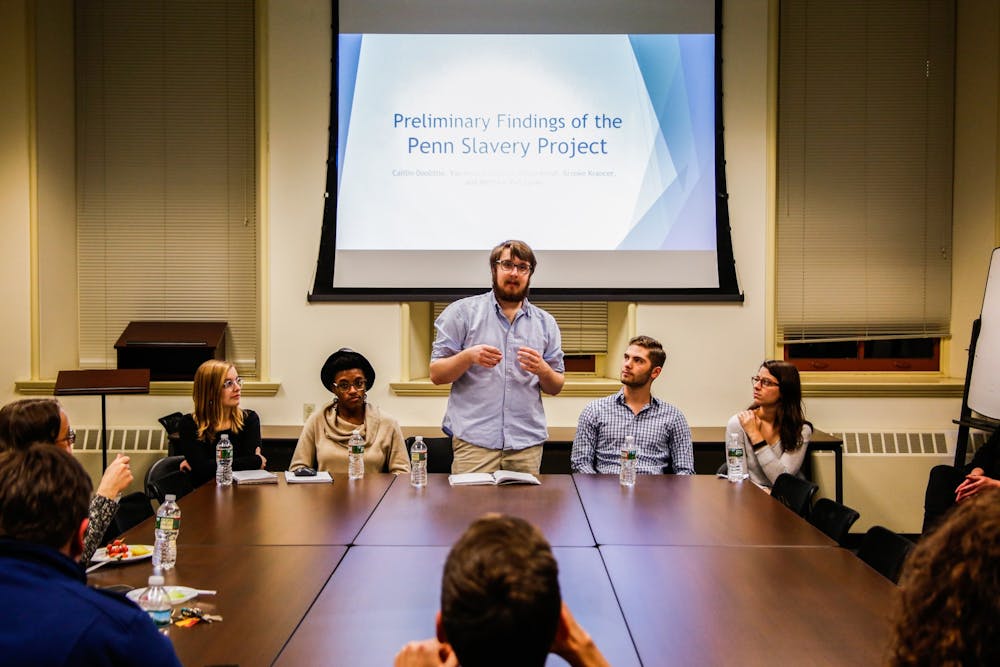The Penn & Slavery Project at Penn resumed its research on the history of Penn’s connection to slavery in the United States last semester following a hiatus during COVID-19.
The Penn & Slavery Project, which is offered as a research seminar cross-listed under the History and Africana Studies departments, invites undergraduates to perform their own research on different aspects of the University’s connections to the institution of slavery over the course of a semester. Students then present their findings at a public showcase after their research concludes at the end of the semester. The course was offered last semester for the first time since 2019.
Since its inception, students involved in the Penn & Slavery Project have researched the impact of slavery on the University’s campus, finances, and medical school, among other aspects.
The project first stemmed from 2018 College graduate VanJessica Gladney, who sought to challenge the statement from University spokesperson Ron Ozio to the Philadelphia Tribune in 2016 that there was “no direct University involvement with slavery or the slave trade.”
In 2017, under the guidance of David Boies Professor of History Kathleen Brown, Gladney and four other undergraduates at the time began researching various topics concerning the University’s ties to slavery. Their initial discoveries led to former President Amy Gutmann appointing a group to “examine the role of slavery in Penn's early years.”
“[The project] originally started when I had a conversation with Professor Brown about Penn’s complicity,” Gladney said. “Then, myself and four other students eventually started researching and the project has grown so much since then.”
In the following years, the Penn & Slavery Project has continued making significant discoveries, including uncovering evidence of Penn receiving funding from slave owners and using the collected bodies of enslaved people for educational purposes. At this year’s symposium — the first since the COVID-19 pandemic began — much of the student research was focused on the medical school, along with the collection and study of anatomical remains.
“There’s a more nuanced, indirect connection that Penn has to slavery, and I think we have as much of a responsibility to spotlight that,” College sophomore and former Daily Pennsylvanian staffer Emma Bhansingh said. “We’re just looking for the truth.”
RELATED:
Over 350 undergraduates present summer research at the Fall Research Expo 2022
Inaugural W.E.B Du Bois lecture aims to honor Du Bois’ legacy at Penn with guest speaker
Brown continues to oversee the project and said that she is primarily there to support the students.
“The Penn & Slavery Project is a student-driven project, which is to say that the students decide the direction of their research and they actually do the research for the findings,” she said.
Students who took the seminar and participated in the project said that their research skills grew as a part of the project.
“It was a good opportunity for me to personally learn more about this subject that I had a very surface-level understanding of,” College junior Hyun Song said. “It's one of the few courses I've taken at Penn that helps the participants with starting research, forming your own research question … and coming to your own conclusion.”
Students also said they experienced challenges while researching because the topic can be emotionally charged.
“It is extremely graphic. You’re looking at anatomical models of bodies,” College sophomore Jenna Boccher said. “What helps keep me sane is … thinking about how this is going to stop somebody else from having to do [this research] or stop this process from being repeated in medicine.”
The project plans to continue to expand outside of the classroom. According to Brown, they regularly update their website with students’ findings and promote their augmented reality app, which provides guided tours of Penn’s campus. The stops on these tours feature short exhibits each illustrating a different story or aspect of Penn’s background as it relates to slavery.
“It's a really amazing tour of campus that allows the research to inform how you experience the campus instead of having it be invisible,” Brown said.
Following COVID-19, the app’s functionality has been updated to allow its use while off campus.
Brown, who has been acting as the lead faculty member since its start, said she is unsure of the future of the project, but she continues to be aspirational about the work.
“I feel that working with these students has absolutely been the highlight of my career,” she said. “I think this is really living up to [Penn’s ideals on undergraduate research] in a way that Penn should be really proud of.”
For the students, they said that they hope the project will continue to focus on how the University can use their research to make up for the past it had long allowed to go unanswered.
“If Penn really is interested in ameliorating these wrongs, the interest shouldn’t be covering up the past,” College senior Joe Anderson said. “They should be acknowledging it and saying, ‘What can we do as an institution now to try to make up for what we've done?’”









